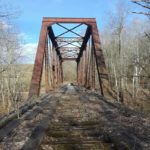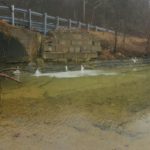Project Gallery
ARCHAEOLOGICAL AND CULTURAL-HISTORIC SURVEYS FOR PROPOSED REHABILITATION AND REPLACEMENT OF BRIDGES IN
KYTC DISTRICTS 1, 2, 3, 5, 6, 8, AND 9, KENTUCKY
Corn Island Archaeology LLC has been completing archaeological and cultural-historic surveys for numerous proposed rehabilitations or reconstructions of bridges located within the Kentucky Transportation Cabinet’s Districts 1, 2, 3, 5, 6, 8, and 9. These surveys are being conducted at the request of Tom Springer of Qk4, Inc., on behalf of the Kentucky Transportation Cabinet as part of the Bridging Kentucky Program. The study is necessary to comply with Section 106 of the National Historic Preservation Act as these transportation projects are federally funded and therefore are considered an undertaking subject to Section 106 review. The purpose was to locate, describe, evaluate, and make appropriate recommendations for the future treatment of any historic properties or sites that may be affected by the project.
Archaeological field methods consist of subjecting the entire project area of potential effects for each bridge to intensive pedestrian survey supplemented with screened shovel testing. Deeper strata are tested using deep auger testing. Both survey types evaluated more recent landuse and the potential of disturbances at each bridge using historical mapping and aerials, including those compiled by the Kentucky Transportation Cabinet in their Project Archives. Data at the Office of State Archaeology and the Kentucky Heritage Council are researched for each bridge location to reveal the presence of and/or potential for cultural resources to be present.
These methods have had varying results and subsequent recommendations. Many have documented an absence of cultural-historic and archaeological materials, while at others archaeological sites, a cemetery, and cultural-historic resources have been identified. Non-site localities and isolated finds have also been documented within the project areas. These projects have resulted in the gathering of much of the statewide research data in-house as well as have provided Corn Island Archaeology with on-the-ground experience throughout the varied environmental and cultural areas of the state










